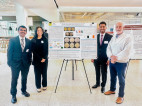California has had 74,936 confirmed cases of COVID-19 and 3,108 deaths caused by the disease to date, the state’s Department of Public Health announced Friday.
As of May 14, local health departments have reported 7,977 confirmed positive cases in healthcare workers and 44 deaths statewide.
Testing in California
As testing capacity continues to increase across the state, the California Department of Public Health is working to expand access to COVID-19 testing. Testing should be used for medical evaluation of persons with symptoms of COVID-19 as well as for efforts by public health agencies and essential employers to prevent and control the spread of COVID-19. Individuals prioritized for testing include:
* Hospitalized patients
* Symptomatic and asymptomatic healthcare workers, first responders, and other social service employees
* Symptomatic individuals age 65 and older or symptomatic individuals of any age with chronic medical conditions that * increase the risk of severe COVID-19 illness
* Individuals who are tested as part of disease control efforts in high-risk settings
* Asymptomatic residents and employees of congregate living facilities when needed to prevent disease transmission
* Symptomatic and asymptomatic individuals in essential occupations such as grocery store and food supply workers, utility workers and public employees
* Other individuals with symptoms consistent with COVID-19
As of May 14, 1,133,906 tests have been conducted in California and reported to the California Department of Public Health. This represents an increase of 29,255 tests over the prior 24-hour reporting period. These numbers include data from commercial, private and academic labs, including Quest, LabCorp, Kaiser, University of California and Stanford, and the twenty-five public health labs currently testing in the state.

New Data Portal
The state has launched a new, user-friendly data portal at update.covid19.ca.gov that tracks COVID-19 cases statewide and by county, gender, age and ethnicity. The portal also outlines statewide hospitalizations and testing efforts. The data presented on the portal will be updated daily and will include additional information as it is available.
Racial Demographics – A More Complete Picture
The California Department of Public Health is committed to health equity and collecting more detailed racial and ethnic data that will provide additional understanding for determining future action. Health outcomes are affected by forces including structural racism, poverty and the disproportionate prevalence of underlying conditions such as asthma and heart disease among Latinos and African American Californians. Only by looking at the full picture can we understand how to ensure the best outcomes for all Californians.
The differences in health outcomes related to COVID-19 are most stark in COVID-19 deaths. We have nearly complete data on race and ethnicity for COVID-19 deaths, and we are seeing the following trends.
Overall, for adults 18 and older, Latinos, African Americans and Native Hawaiians and Pacific Islanders are dying at disproportionately higher levels. The proportion of COVID-19 deaths in African Americans is about double their population representation across all adult age categories. For Native Hawaiians and Pacific Islanders, overall numbers are low, but there is nearly a four-fold difference between the proportion of COVID-19 deaths and their population representation. More males are dying from COVID-19 than females, in line with national trends.
More information is available at COVID-19 Race and Ethnicity Data.
How People Can Protect Themselves
There is currently no vaccine to prevent COVID-19. The best way to prevent illness is to avoid being exposed to this virus.
The virus spreads mainly from person-to-person between people who are in close contact with one another (within about 6 feet). This occurs by respiratory droplets produced when an infected person coughs or sneezes. These droplets can land in the mouths or noses of people who are nearby or possibly be inhaled into the lungs. Surfaces can also get infected.
Older adults and people who have severe underlying medical conditions like hypertension, obesity, heart or lung disease, diabetes or asthma seem to be at higher risk for developing more serious complications from COVID-19 illness.
Every person has a role to play. So much of protecting yourself and your family comes down to common sense:
* Stay home except for essential needs/activities.
* Practice physical distancing – stay 6 feet away from people.
* Wear a cloth face mask if you leave home.
* Wash hands with soap and water for at least 20 seconds.
* Clean and disinfect frequently touched surfaces daily. If surfaces are dirty, clean them using detergent or soap and water prior to disinfection.
* Avoid touching eyes, nose or mouth.
* Cover your cough or sneeze with a tissue or your elbow or a tissue. Wash hands afterward.
* Avoiding close contact with people who are sick.
* Stay home and away from people if you become sick with respiratory symptoms like fever and cough.
* If you smoke or vape, consider quitting. Smoking and vaping cause harm to the lungs.
* Follow guidance from public health officials.
If you are at higher risk for serious illness from COVID-19 because of your age or health condition, it is important for you to take extra actions to reduce your risk of getting sick with the disease:
* Stay home. It’s the most important thing you can do.
* Avoid contact with people who are sick. Isolate anyone sick in your home in a separate room, if possible.
* Consider ways of getting food brought to your house through family, social, or commercial networks. Wipe off containers with disinfectant wipes.
It is also important that you listen to public health officials who may recommend community actions to reduce potential exposure to COVID-19, especially if COVID-19 is spreading in your community.
For more information visit the CDC’s website.
For county-level data, access the COVID-19 Public Dashboard.
For skilled nursing facility data, visit Skilled Nursing Facilities: COVID-19.
For more information about what Californians can do to prevent the spread of COVID-19, visit Coronavirus (COVID-19) in California.
California continues to issue guidance on preparing and protecting California from COVID-19. Consolidated guidance is available on the California Department of Public Health’s Guidance webpage.
Like this:
Like Loading...
Related





 Tweet This
Tweet This Facebook
Facebook Digg This
Digg This Bookmark
Bookmark Stumble
Stumble RSS
RSS



























REAL NAMES ONLY: All posters must use their real individual or business name. This applies equally to Twitter account holders who use a nickname.
0 Comments
You can be the first one to leave a comment.